Discharge planning (DP) is the development of a personalized plan to ensure the smooth transition of a patient from a health organization such as a hospital to wherever the patient is going next such as a home, residential care, palliative care, or somewhere else. The aim of DP is to reduce length of stay, lower unplanned readmissions, and to improve the coordination of services following discharge.
Who is involved and what is included?
Effective DP incorporates an interprofessional team approach. DP involves the patient, family and any staff involved in the patient’s care. Usually there will be one person, such as a discharge planner, who coordinates the process. When a patient is admitted, it is important for the treatment team to identify what a patient will need after discharge and start working to ensure those needs will be met. This includes identifying any services, equipment or follow-up that may be needed to safely transition the patient home or elsewhere. Every discharge plan will differ depending on the patient however identifying these needs prior to discharge will promote positive patient outcomes and help prevent adverse events.
patient will need after discharge and start working to ensure those needs will be met. This includes identifying any services, equipment or follow-up that may be needed to safely transition the patient home or elsewhere. Every discharge plan will differ depending on the patient however identifying these needs prior to discharge will promote positive patient outcomes and help prevent adverse events.
What are the benefits of discharge planning?
Individualized discharge plans have the ability to reduce delayed transition due to non-medical factors, contain costs, and improve patient outcomes. Patients should participate in DP as this improves their experience and can result in better health outcomes. DP can also positively affect clinician satisfaction and avoid medication errors or complications that could lead to possible readmissions.
When should DP begin?
It is never too early to start DP. In fact, experts say the sooner discharge planning is begun, the better. Prior studies have shown that an early discharge preparation process can significantly decrease hospital length of stay (LOS), readmission risk and mortality risk. As such, discharge planning should begin as soon as possible.
Discharge planning is an essential component in providing high quality care. DP should begin early, be patient-specific and include all members of the treatment team. It is important to have a solid discharge plan in place to safely transition the patient to home or elsewhere. Good discharge planning can avoid complications after discharge, errors with medications and can help prevent patient readmissions.
References (accessed 11/1/2022)
healthdirect.gov.au
psnet.ahrq.gov
safetyandquality.gov
pubmed.ncbi.nlm.nih.gov
| Editor’s Note: Good discharge planning can avoid complications after discharge, errors with medications and can help prevent patient readmissions. CLICK HERE and we can discuss how BHM can play a part in your organization’s discharge planning process. |
